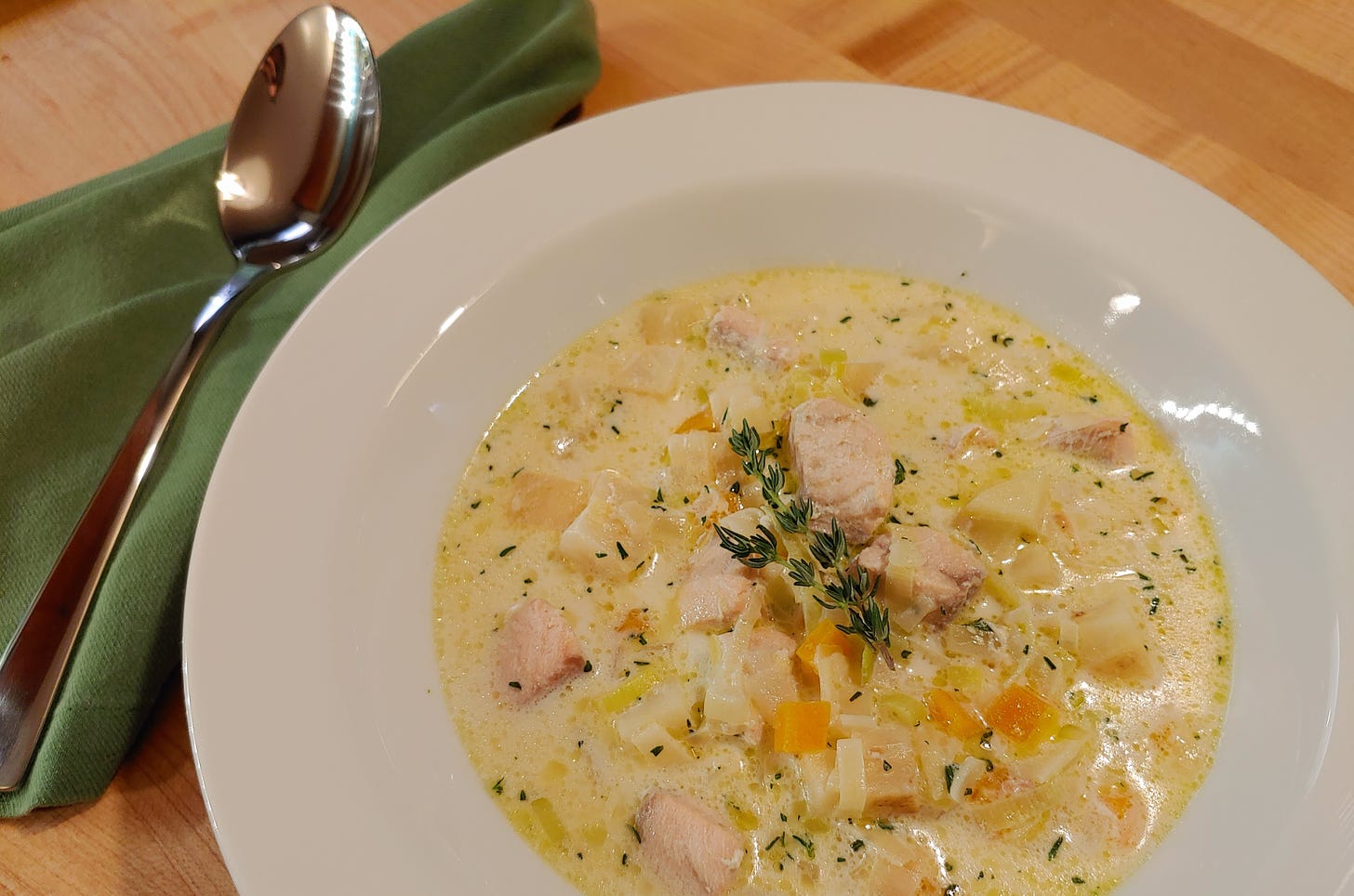No. 15: Celebrating Seafood
...all year (not just this month), plus a trio of recipes ideal for autumn
It’s October, so that means it’s time for National Seafood Month. As you may have noted from these newsletters over the past year, I don’t focus much on calendar-oriented celebrations related to seafood. It’d probably be smart of me to do so, cookbook authors value every opportunity for a bit of timely promotion of a book. So allow me to wish a belated Happy National Oyster Day (August 5) to you all.
Of course I’m all for the extra attention that seafood’s many attributes may be receiving this month. I prefer, though, to embrace the mode of “every day is [[fill in the blank with your favorite seafood]] day” (a variation of which I overheard regarding the recent National Coffee Day). It’s the general premise behind Seafood Savvy: celebrating seafood all year in a wide range of ways.
The seafood-related calendar dates I can get fully behind are those we get in the car (train, plane, etc.) to experience first-hand: seafood festivals. I’m just home from one in Maryland that I’ve been wanting to get to for many years, since I learned about it while attending the Shelton OysterFest ages ago. The 57th annual U.S. Oyster Festival in St. Mary’s County was held this past weekend, I’ll share more about it down the line, for now a few photo highlights. Next year I really need to get back to the Shelton festival, it’s been far too long.

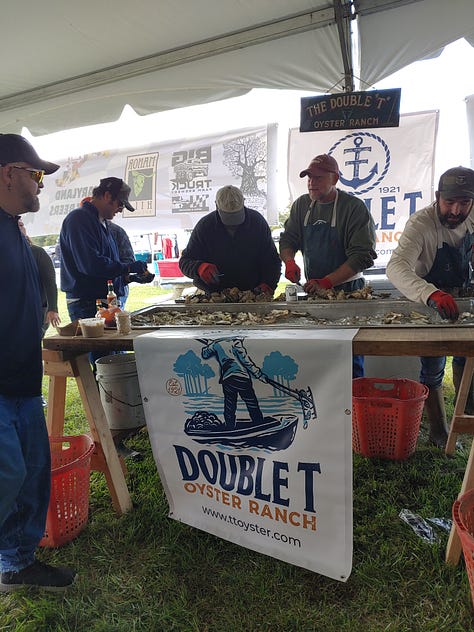
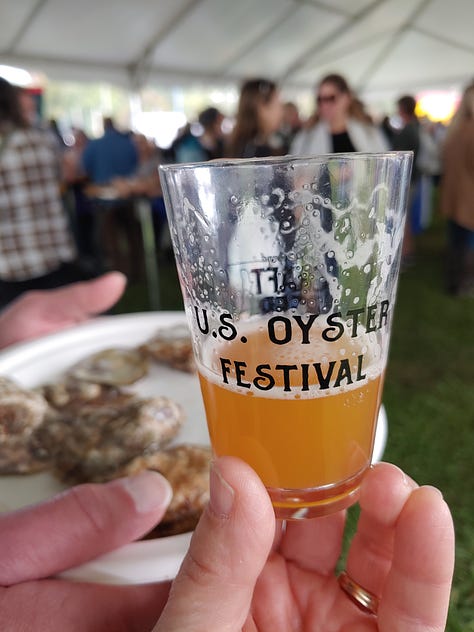
This issue’s version of celebrating seafood focuses on the kitchen. I think all but one of these newsletters to date have included a recipe, mixed in with the array of whatever other seafoody topics I’m going on about at the moment. To give the culinary side of things a bit more attention, my plan going forward is to have a mostly-recipes issue every other newsletter or so.
The recipes will include old favorites and new inspirations, a recipe from a book (mine or others’) or something I dreamed up for dinner a couple nights before…covering a broad range of styles and approaches. Over time I hope all the recipes I share here not only inspire heading into the kitchen to recreate some of them yourself, but also offer some encouragement to try different ingredient combos and cooking techniques now and then, pick up some ideas to tweak and apply your own spin to. I’m a big supporter of the delicious fun that can come with off-the-cuff creations. Seafood is nothing if not versatile and ready to satisfy any particular mood or occasion.
Salmon and Celery Root Chowder
This was a big year for the pink salmon run in the Puget Sound area. On my frequent morning walks through Lincoln Park I’d witnessed hundreds of fishermen over a couple months fishing shoulder-to-shoulder along the park’s beach—plenty of them hauling in fish as I walked past. Though I never cast a line into the water, my basement freezer has a generous amount of frozen pink salmon portions, the gift of a friend who’d caught some last month.
With that gift as inspiration, I pulled out a recipe from my Salmon cookbook that I wrote about twenty years ago. I made this light chowder with sunchokes for the book’s version, I loved their nutty-earthy-slightly sweet flavor in the soup. But they can be hard to find, and a bit hard on one’s digestion, so I swapped them out for another favorite vegetable that also has nutty-earthy character. I used about half of a medium celery root, its tough, knobby skin peeled away (carefully!) with a knife before cutting into scant 1/2-inch dice. Feel free to use peeled and diced sunchokes instead, or a good waxy potato (Yukon Gold would be great). Keep in mind that cooking time may vary based on size and density of whatever option you choose.
Pink salmon is not among the more heralded of salmon species, its flesh leaner, lighter in color and a bit softer than that of other salmon. It is, however, a wonderful fish still worthy of attention (in the past I’ve had great results grilling pinks whole). Whatever salmon you have on hand will be great in this recipe. And I bet flaked hot-smoked salmon would be outstanding here, too! I need to try that next time.
In the salmon cookbook, I suggested readers make salmon stock to have on hand for uses such as this, much the way I now go on incessantly about saving crab/shrimp/lobster shells for making shellfish stock. Because I have the latter in my freezer and haven’t made the former in some time, I made this with shellfish stock—perfectly delicious.
3 tablespoons unsalted butter
About 2 cups diced peeled celery root
1/2 medium onion, finely chopped
1 large or 2 mediums carrots, cut into 1/2-inch dice
1 large or 2 medium leeks, white and pale green parts only, split, cleaned, and thinly sliced
Salt and freshly ground black pepper
4 cups salmon stock, fish stock, or shellfish stock
2 cups half-and-half
1 pound salmon fillet, skin and pin bones removed, cut into 3/4-inch dice
1 teaspoon minced fresh thyme
Melt the butter in a medium soup pot over medium heat. Add the celery root, onion, carrot, leek, and a good pinch each of salt and pepper. Sauté, stirring occasionally, until the vegetables begin to soften, 8 to 10 minutes (the vegetables shouldn’t brown; reduce the heat if needed). Add the stock and half-and-half. Bring the liquid just to a low boil over medium-high heat, then reduce the heat to medium-low and simmer until the vegetables are tender, about 20 minutes.
Add the salmon and thyme to the chowder. Simmer, stirring very gently once or twice, just until the salmon is cooked through, 3 to 4 minutes. Taste the chowder for seasoning, adding more salt or pepper to taste. Ladle the chowder into individual bowls and serve right away.
Makes 4 to 6 servings
Marinated Mussels with Fennel
Hama Hama Oysters west of Seattle on Hood Canal is among producers that ship their shellfish direct to consumers. It made me eternally grateful to rely on them and a couple of other growers while writing my shellfish cookbook at the start of the pandemic: outstanding seafood arriving on my doorstep saved needing to shop around town for at least some of my recipe-testing ingredients.
They amped up their home-delivery game with a new twist in the spring of 2021. This new addition they call Oysters & Friends, a sort of CSF—community supported fishery—delivered once a month. Each box is a bit like seafood-lover’s Christmas, a different mix of things each time, starting with shellfish from their own production. The “& Friends” might include other seafood (Dungeness crab, spot prawns, black cod) as well as accoutrements (interesting mignonettes, seasoned butter or a soup base) and other treats (wild mushrooms, sea beans among them). I’ve signed up for three or four of the 6-month subscriptions, which usually sell out pretty quickly. On occasion you might find a single-box option in their online store during a month when they have extra. Sign up for their mailing list and you’ll be in the loop about both.
The box of goodies I got last month included a couple pounds of mussels. With friends coming over for dinner, I decided to use the mussels as an appetizer, opting to marinate them to serve as one of many items for a snack-heavy start to the meal. To join the mussels, I selected one of the cans carried home from Conservas Pinhais in Portugal this spring, and served smoked salmon collars I had in the fridge from the prior week’s visit to Josephson’s Smokehouse in Astoria, Oregon. Other items included some quick-pickled purple cauliflower, fried sage leaves, cheese, toasted nuts, crackers—it was a fun and varied spread.
I winged it with the mussels, drawing on various recipes I’ve made and dishes I’ve eaten over the years. It was a very easy prep of a simple marinade (akin to a vinaigrette), steamed mussels, and fresh fennel bulb. I didn’t capture all the details as I went, reconstructing here from memory.
Before steaming the mussels, I whisked together about 1/3 cup of white wine vinegar and a generous 1/2 cup or so of olive oil. More vinegar-heavy than I do for a vinaigrette, and I skipped the Dijon I’d usually add for a salad dressing. To that I added a good pinch of kosher salt and a few grindings of black pepper. Prepped for adding later, I diced about 1 cup of fennel bulb and chopped a few tablespoons of tender fennel fronds (when shopping, choose a bulb that has a good amount of tender fronds, if possible).
After rinsing and de-bearding the 2 pounds of mussels, I put them in a large pot and added about 1/4 cup of water. (Very little water is needed to simply steam them open, I use more if the cooking liquids are beneficial for the finished dish; feel free to use dry white wine instead if you like.) In their covered pot, the mussels cooked over medium-high heat for a few minutes, then I gave them a bit of a stir, covered the pot again and cooked another minute or two until all (or at least most) mussels opened.
It’s ideal to add the mussels to the marinade while still warm, they more quickly absorb flavors while warm. So as soon as comfortable to do so, I plucked the meats from the shells and added them to the marinade. (Any unopened mussels can be cooked another minute or so, but if they don’t open, discard them.)
The fennel bulb and fronds were then stirred into the mussels, the mixture then refrigerated to marinate until ready to serve. I made this in the morning to serve that evening, which worked well. I think it’ll be ideal to allow at least a few hours in the fridge for the mussels to marinate. Stirring every hour or so helps ensure even marination.
I kept the seasoning minimal, letting this be all about the mussels and the fennel. You could add a bit of minced shallot and/or garlic, some chives or a bit of thinly sliced green onion. But I think this is a good time to keep it simple. The mussels and fennel can be served as is, with sliced bread or crackers alongside.
Endive & Radicchio Salad with Fried Oysters & Hazelnuts
The topic of pan-fried oysters came up when chatting with a friend recently, and she immediately volunteered that she’s “team cornmeal” when it comes to the coating. I may have some pretty strong feelings about certain ingredients and cooking techniques, but when it comes to this preparations I’m pretty open-minded. Though I definitely understand her love of that extra crunch and nutty flavor that cornmeal brings to the party: in Shellfish I included a recipe for cornmeal-coated fried oysters with a pickled-pepper tartar sauce. I’ve played around with lots of coating options, different flours and crumbs and seasonings, lots of potential for interesting variations in texture and flavor.
I do, however, tend to prefer the classic old-school approaches: all-purpose flour, breadcrumbs or maybe saltine cracker crumbs on occasion for extra-crispy panache. You can opt for the triple-dip approach: first in flour, then in milk or a milk/egg mixture, then in bread crumbs/cracker crumbs. It makes for a more substantial coating, but I find a lighter single coating is perfectly delicious and love the less-fussy prep. The flour or crumbs can be seasoned various ways, allowing for flavor embellishment while still keeping things simple.
A plate of pan-fried oysters with a good tartar sauce, it’s one of my all-time favorite dinners. Filling a whole book with oyster recipes gave me a chance to play around with the theme: a couple toward the classic (flour- and cracker crumb-coated), plus panko-coated for sliders (with togarashi slaw) and in a light chickpea flour batter (served with vegetables in pita bread).
I took a salad turn with fried oysters in this recipe below, adding hazelnuts to the mix and serving the oysters atop two of my favorite salad components: Belgian endive and radicchio. A delicious, colorful combo as we slide into fall.
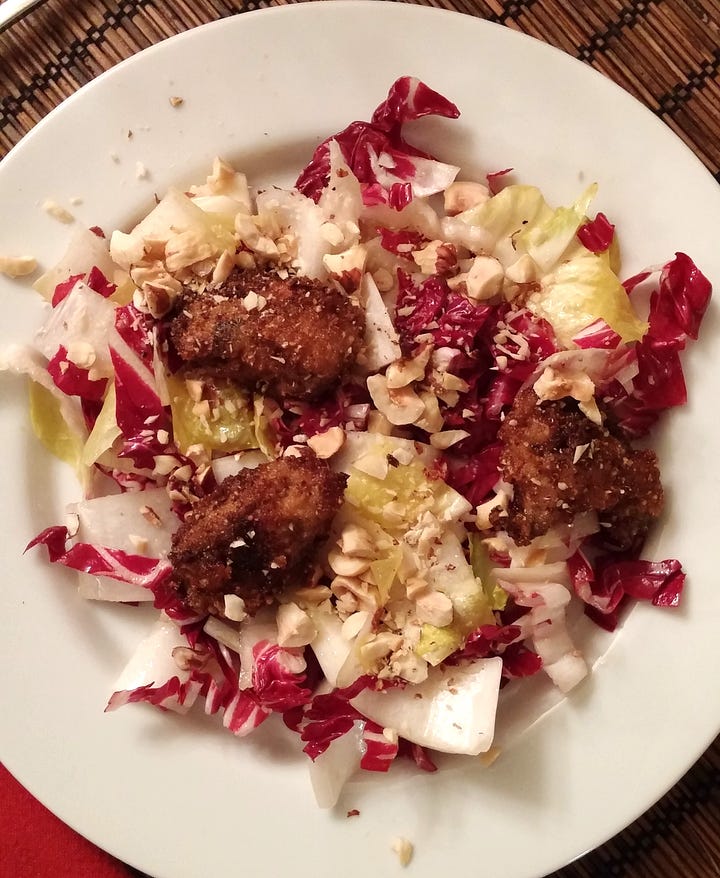
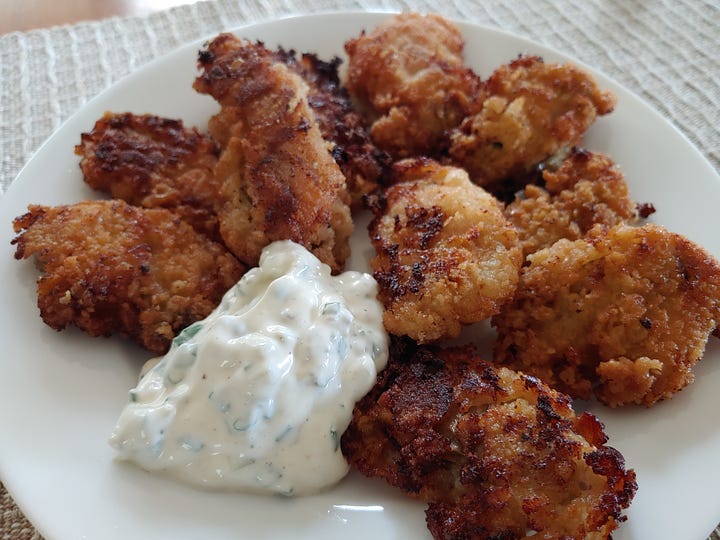
4 large heads Belgian endive (about 3/4 pound)
1 small head radicchio (about 8 ounces)
1 cup hazelnuts (about 4 ounces), lightly toasted and skinned, divided
3/4 cup fine dried bread crumbs
Kosher salt and freshly ground black pepper
3 tablespoons red wine vinegar
1 teaspoon Dijon mustard
1/4 cup mild olive oil, plus more for frying
2 tablespoons hazelnut oil (optional)
18 freshly shucked small to medium oysters or jarred extra-small oysters, with their liquor
Preheat the oven to 200°F. Line a rimmed baking sheet with brown paper or paper towels and set an oblong wire rack on top, if you have one.
Trim the stem ends from the endive and discard any blemished outer leaves. Cut each endive in half lengthwise and cut away the triangular core from the base. Cut across each half into roughly 3/4-inch pieces. Put the endive in a large bowl.
Halve the radicchio and cut away the tough core. Discard any blemished outer leaves. Cut across each half into slices about 1/4 inch thick and add them to the bowl with the endive. Cover with a damp kitchen towel or paper towels and set aside.
Put 1/2 cup of the hazelnuts in a food processor and pulse until finely ground (take care not to overgrind or you might end up with hazelnut butter). Add the bread crumbs and a good pinch each of salt and pepper, and pulse a few times to blend. Transfer the mixture to a plate. Coarsely chop the remaining 1/2 cup hazelnuts.
In a small bowl, whisk together the vinegar and mustard with a good pinch each of salt and pepper. While whisking, drizzle in the olive and hazelnut oils.
Heat about 1/4 inch of olive oil in a large heavy skillet, such as cast iron, over medium heat. Keep in mind that the heavier the pan, the longer it will take to preheat.
While the oil is heating, toss 2 or 3 oysters at a time in the nut-crumb mixture, coating each oyster well and patting to remove excess. When the oil is heated, carefully add about 6 of the oysters (don’t crowd the pan; cook fewer if needed) and cook until nicely browned, about 3 minutes. Turn the oysters and brown on the second side, 2 to 3 minutes longer. Transfer the oysters to the prepared baking sheet and keep them warm in the oven while frying the remaining oysters. Add a bit more oil to the pan and allow it to reheat if needed between batches.
Rewhisk the dressing to mix, then pour it over the endive and radicchio and toss well to evenly coat. Arrange the salad on individual plates and top with the oysters. Sprinkle with the chopped hazelnuts and serve right away.
Makes 2 to 3 main course servings or 6 appetizer servings





